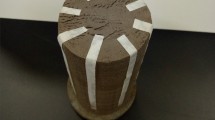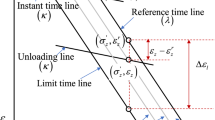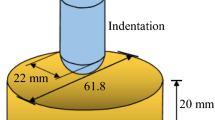Abstract
To study the settlement process of high-filled embankment before and after construction, an elastic viscoplastic constitutive model of over-consolidated soil is designed based on finite element analysis. The model is used to predict the settlement of subgrade before and after construction. First, the lower load surface is used as the reference yield surface of strain rate. Based on the principle of relative over stress, two rate sensitive parameters are established through the measurement of triaxial compression test with different strain rates. Second, the relative over stress function, stress function, and dynamic yield criterion function are established. Finally, two kinds of over-consolidated soils with over-consolidation ratios of 16 and 8 are tested for triaxial shear creep, and the finite element software is used for simulation analysis. The results show that the ultimate axial strain decreases with the decrease of deviatoric stress. When the creep time exceeds 3000min, the model has good prediction effect. The finite element calculation results of different backfill layers in inversion parameters show that the maximum settlement layer of high-filled embankment may not occur at the top or bottom, so attention should be paid in the construction process of high-filled embankment. This exploration provides a reference for the study of long-term deformation and strength of high-filled embankment.







Similar content being viewed by others
References
Ali SF, Fan J (2020) Elastic-viscoplastic constitutive model for capturing the mechanical response of polymer composite at various strain rates. J Mater Sci Technol 57:12–17
De QY, Chang WY, Shu GL et al (2019) Stress-strain constitutive model of concrete corroded by saline soil under uniaxial compression. Constr Build Mater 213:665–674
Dong WL, Jun HC, Yan Z (2018) A study of coupled creep damaged constitutive model of artificial frozen soil. Adv Mater Sci Eng 8:1–9
Fu T, Zhu Z, Zhang D, Liu Z, Xie Q (2019) Research on damage viscoelastic dynamic constitutive model of frozen soil. Cold Reg Sci Technol 160:209–221
Gholizadeh E, Latifi M (2018) A coupled hydro-mechanical constitutive model for unsaturated frictional and cohesive soil. Comput Geotech 98:69–81
Hoskera AK, Nico G, Ahmed MI et al (2020) Accuracies of soil moisture estimations using a semi-empirical model over bare soil agricultural croplands from sentinel-1 SAR data. Remote Sens 12(10):1664
Li W, Yang Q (2018a) Hydromechanical constitutive model for unsaturated soils with different overconsolidation ratios. Int J Geomech 18(2):142–146
Li WG, Yang Q (2018b) Implicit integration algorithm of hydro-mechanical constitutive model for overconsolidated unsaturated soils and its application. Yantu Gongcheng Xuebao/Chin J Geotech Eng 40(9):1652–1658
Li H, Feng S, Wei L, Chen Z (2019a) Time effect of pile-soil interaction and its elastic-viscoplastic constitutive model. Rudarsko-geološko-naftni zbornik 34(1):1–11
Li D, Zhang C, Ding G et al (2019b) Fractional derivative-based creep constitutive model of deep artificial frozen soil. Cold Regions Sci Technol 170:102942
Lv M, Xu Z, Zong LY (2020) Cloud resolving WRF simulations of precipitation and soil moisture over the central Tibetan plateau: an assessment of various physics options. Earth Space Sci 7(2):2
Ma WB, Zhao ZG, Li P, Liu Q, Yang CQ, Li J, Luo WB (2019) Shear creep properties of weak interlayer in slope based on stationary parameter fractional derivative burgers model. Soils Rocks 42(3):337–348
Prasad VR, Gaffar SA, Kumar BR (2019) Non-similar comutational solutions for double-diffusive MHD transport phenomena for non-newtnian nanofluid from a horizontal circular cylinder. Nonlinear Eng 8(1):470–485
Rachdi S, Jahangir E, Tijani M et al (2019) Tunnelling-induced surface settlement, pp. on the choice of soil constitutive model. Eur J Environ Civ Eng 2:1–18
Saberi M, Annan CD, Konrad JM (2018) A unified constitutive model for simulating stress-path dependency of sandy and gravelly soil-structure interfaces. Int J Non-Linear Mechan 102:1–13
Saberi M, Annan CD, Konrad JM (2019) Implementation of a soil-structure interface constitutive model for application in geo-structures. Soil Dynam Earthquake Engi Southampton 116:714–731
Saberi M, Annan CD, Konrad JM (2020) Three-dimensional constitutive model for cyclic behavior of soil-structure interfaces. Soil Dyn Earthq Eng 134:106162
Spears R, Veeraraghavan S, Coleman J (2019) Nonlinear modeling of ground motions at Lotung LSST site with nested surface soil constitutive model. Nucl Technol 205(9):1205–1218
Sun K, Chen ZL, Lu DC (2018) An elastoplastic constitutive model incorporating cementation effect of stabilizer-treated soils. Yantu Lixue/Rock Soil Mech 39(5):1589–1597
Wang B, Kari L (2020) A visco-elastic-plastic constitutive model of isotropic magneto-sensitive rubber with amplitude, frequency and magnetic dependency. Int J Plast 132:1082
Wen JG, Guo JH, Jian KZ et al (2018) Study on constitutive model of air-foam-treated lightweight soil based on static triaxial test. IOP Conference Series Earth and Environmental Science 170:22152
Yang D, Yan C, Liu S, Zhang J, Hu Z (2019) Stress-strain constitutive model of concrete corroded by saline soil under uniaxial compression. Constr Build Mater 213:665–674
Zhi CW, Qian YZ, Guang CL et al (2018) Analysis on time-dependent deformation behavior and long-term settlement of compacted clay of high-filled embankment. J Highw Transp Res Dev 6(1):70–85
Zhou WH, Tan F, Yuen KV (2018) Model updating and uncertainty analysis for creep behavior of soft soil. Comput Geotech 100:135–143
Acknowledgements
M. Yanhao Zheng is grateful to the China Grants Council for the award of a full scholarship (CSC No. 201808060470) allowing him to carry out his research at UCL.
Funding
This work was finally supported by the National Key Research and Development Program of China (Grant No. 2017YFC1501305) and the Research Start-up Fund of China University of Geosciences (Wuhan) (Grant No. 162301192680).
Author information
Authors and Affiliations
Corresponding author
Additional information
Responsible Editor: Keda Cai
This article is part of the Topical Collection on Geological Modeling and Geospatial Data Analysis.
Rights and permissions
About this article
Cite this article
Zheng, Y., Fan, Z., Tan, Q. et al. Construction of elastic viscoplastic constitutive model and settlement control of over-consolidated soil using finite element software ABAQUS. Arab J Geosci 14, 257 (2021). https://doi.org/10.1007/s12517-021-06585-7
Received:
Accepted:
Published:
DOI: https://doi.org/10.1007/s12517-021-06585-7




